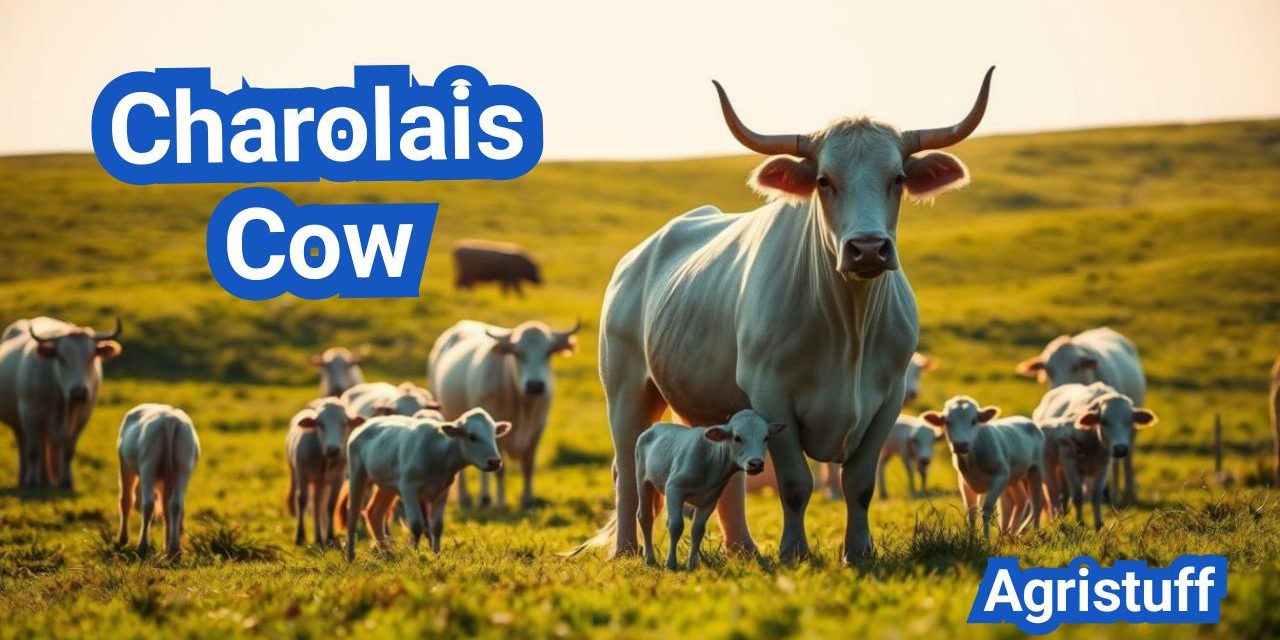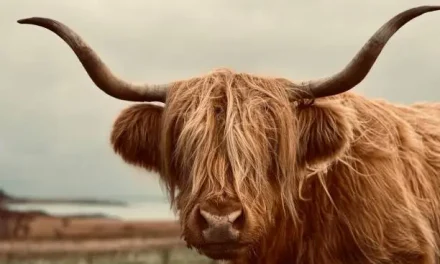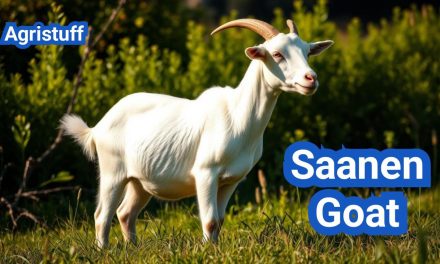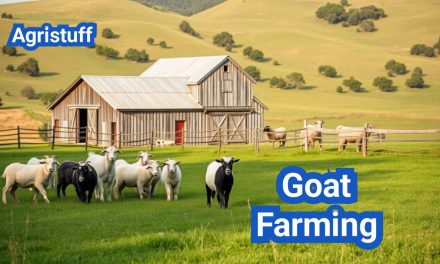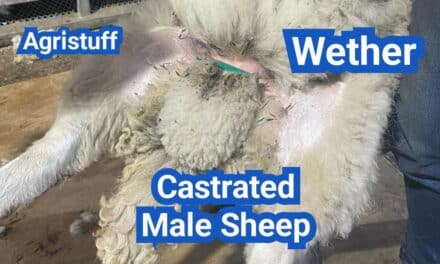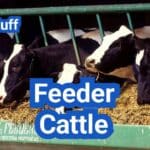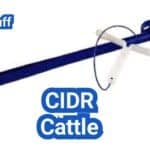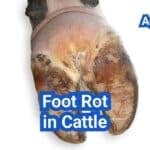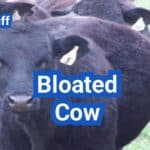The Charolais cow is a renowned breed in the cattle farming industry, prized for its exceptional beef quality.
Originating in France, this breed has become a staple in lean beef cattle farming globally, including the United States, where it is valued for its rapid growth rate and high-quality meat.
As one of the prominent beef cattle breeds USA, the Charolais cow is recognized for its muscular build and white or cream-colored coat.
Key Takeaways
- Charolais cows are known for their high-quality beef and rapid growth rate.
- They are a popular choice in lean beef cattle farming.
- The breed is widely used in the United States for its desirable traits.
- Charolais cattle are recognized for their muscular build and white or cream-colored coat.
- They are a significant part of the beef cattle industry globally.
The History and Origin of Charolais Cattle
With roots tracing back to medieval France, Charolais cattle have evolved into one of the world’s most recognized beef breeds. The Charolais breed originated in the Charolles region of France, an area known for its rich agricultural heritage.
French Beginnings: The Birthplace of Charolais
The history of Charolais cattle is deeply intertwined with the agricultural practices of medieval France. The breed was initially developed in the 8th century, with selective breeding programs aimed at creating a robust and hardy cattle breed. The Charolles region, with its fertile pastures, provided an ideal environment for the breed’s development.
Charolais cattle were highly valued for their strength, size, and meat production capabilities. By the 18th century, the breed had gained popularity not only in France but also beyond its borders, as farmers and ranchers sought to improve their local cattle stocks.
Introduction to North America and Global Spread
The introduction of Charolais cattle to North America marked a significant milestone in the breed’s history. The first Charolais cattle were imported to the United States and Canada in the mid-20th century. This introduction was driven by the desire to improve the quality and yield of beef cattle.
The Charolais breed quickly gained popularity in North America due to its exceptional growth rate and muscle development. Today, Charolais cattle are found in many countries around the world, contributing significantly to global beef production.
The global spread of Charolais cattle is a testament to the breed’s versatility and the value it brings to beef production systems. As the demand for high-quality beef continues to grow, the Charolais breed remains at the forefront of the industry.
Understanding the Charolais Cow Breed

Understanding the Charolais cow breed is crucial for anyone involved in the cattle industry, given its popularity and advantages. The Charolais breed is known for its muscular build and white or cream-colored coat, characteristics that have made it a staple in modern beef production.
Breed Standards and Classification
The Charolais breed adheres to specific standards that define its classification within the beef cattle category. These standards include a muscular build, a white or cream coat, and a robust skeletal structure. The breed is classified based on its genetic purity, with purebred Charolais cattle being highly valued for their breeding potential.
Key characteristics of the Charolais breed include:
- Muscular build and robust skeletal structure
- White or cream-colored coat
- High growth rate and efficient feed conversion
- Genetic purity for classification
Popularity in Modern Beef Production
The Charolais breed has gained significant popularity in modern beef production due to its superior growth rates, efficient feed conversion, and high-quality beef yield. Farmers and producers favor the breed for its ability to improve herd quality and increase profitability.
The advantages of Charolais in beef production are multifaceted:
- Fast growth rates reduce the time to market
- Efficient feed conversion lowers production costs
- High-quality beef yield enhances product value
The Charolais cow breed continues to be a preferred choice in the cattle industry due to its breed standards, classification, and the value it brings to beef production. Its popularity is a testament to the breed’s quality and the advantages it offers to farmers and producers.
Physical Characteristics of Charolais Cattle
The Charolais cattle breed is renowned for its striking appearance and robust physical attributes. One of the most distinctive features of Charolais cattle is their white or cream-colored coat, which is a hallmark of the breed.
Distinctive White Coloration
The white coloration of Charolais cattle is not just aesthetically pleasing; it also has practical advantages. Their light coat color is associated with a lower risk of heat stress, making them suitable for various climates. The white coat is a breed standard, although some Charolais may exhibit a slight creaminess or even a few red hairs, especially around the ears and muzzle.
Body Structure and Conformation
Charolais cattle are known for their muscular build and robust body structure. They have a deep, well-sprung ribcage and a well-muscled loin, contributing to their overall muscular appearance. The breed’s conformation is characterized by a straight or slightly convex profile, a strong topline, and well-developed hindquarters.
Their body structure is designed for efficient growth and meat production. Charolais cattle have a sturdy skeletal system that supports their muscular development, making them a popular choice for beef production.
Identifying Quality Traits in Breeding Stock
When selecting Charolais breeding stock, several physical characteristics are considered to ensure the quality and potential of the animals. Key traits include a robust bone structure, muscular development, and a healthy coat condition. Breeders also look for animals with a good temperament and structural correctness.
Evaluating the physical characteristics of Charolais cattle involves assessing their overall conformation, muscle development, and breed-specific traits. By focusing on these quality traits, breeders can select superior breeding stock that will enhance the overall quality of their herd.
Size and Weight Specifications
Understanding the size and weight specifications of Charolais cattle is crucial for farmers and breeders. Charolais cattle are known for their substantial size and weight, characteristics that are highly valued in beef production.
Average Weight of Mature Charolais Cows
Mature Charolais cows typically weigh between 1000-1400 pounds. This weight range is a result of selective breeding practices that have enhanced the breed’s size and muscularity over the years. The average weight can vary based on factors such as genetics, nutrition, and management practices.
Average Weight Range: 1000-1400 pounds
Size Comparison to Other Beef Breeds
Charolais cattle are generally larger than many other beef breeds. For example, they tend to be larger than Angus cattle, which typically weigh between 900-1300 pounds. In comparison to smaller breeds like the Dexter, Charolais cattle are significantly larger and heavier.
| Breed | Average Cow Weight (lbs) |
|---|---|
| Charolais | 1000-1400 |
| Angus | 900-1300 |
| Dexter | 600-1000 |
Weight Variations Between Bulls and Cows
There is a significant weight difference between Charolais bulls and cows. Bulls are generally larger and heavier, with mature bulls weighing between 1500-2000 pounds or more. This difference is due to the breed’s muscular development and the selective breeding for larger, more muscular sires.
Weight Range for Bulls: 1500-2000 pounds or more
In conclusion, the size and weight specifications of Charolais cattle make them a prominent breed in beef production. Understanding these characteristics is essential for effective breeding and management practices.
Temperament and Behavior Traits
One of the standout characteristics of Charolais cattle is their calm and docile temperament. This trait makes them particularly appealing to farmers and ranchers who prioritize ease of handling and management.
General Disposition of Charolais Cattle
Charolais cattle are known for their gentle disposition. This characteristic is beneficial for both small-scale and large-scale farming operations, as it reduces the risk of injury to handlers and simplifies the overall management of the herd.
According to a study on cattle temperament, the docility of Charolais cattle contributes significantly to their popularity in beef production, as noted by cattle breeding experts.
Handling Techniques for Different Age Groups
Handling Charolais cattle effectively requires an understanding of their behavior at different ages. For young calves, gentle and calm handling is crucial to prevent stress and promote healthy development.
- For calves: gentle handling and minimal restraint
- For yearlings: consistent training and socialization
- For mature cattle: regular handling to maintain docility
Training and Socialization Methods
Training and socialization are key components of managing Charolais cattle. Early socialization helps in reducing stress and improving the overall temperament of the animals.
| Age Group | Training Method | Socialization Technique |
|---|---|---|
| Calves | Gentle handling | Exposure to various environments |
| Yearlings | Consistent training routines | Interaction with other cattle |
| Mature Cattle | Regular, calm handling | Minimal mixing with aggressive animals |
By adopting these methods, farmers can enhance the temperament and behavior of their Charolais cattle, leading to a more manageable and productive herd.
Charolais Cow Traits for Beef Production

Among beef cattle breeds, Charolais stand out for their impressive growth rates and meat quality. The Charolais breed has been developed over centuries to excel in beef production, offering a combination of desirable traits that make it a preferred choice for many producers.
Meat Quality and Yield Grade
Charolais cattle are prized for their high-quality beef, characterized by a leaner meat profile without compromising on tenderness. The yield grade, which is a measure of the amount of usable meat from a carcass, is typically high in Charolais cattle due to their muscular structure. This results in a higher proportion of saleable meat, making them economically viable for beef production.
Meat quality is further enhanced by the breed’s genetic predisposition towards fine marbling, which is essential for tender and flavorful beef. Producers often select Charolais for their breeding programs to leverage these advantages.
Marbling and Tenderness Characteristics
The marbling ability of Charolais cattle contributes significantly to the tenderness and palatability of their beef. Marbling refers to the intramuscular fat that disperses throughout the meat, enhancing its flavor and texture. While Charolais are known for their lean meat, they still exhibit a satisfactory level of marbling, especially when crossed with other breeds that are known for their marbling characteristics.
Tenderness is another critical factor that Charolais cattle bring to the table. Their beef is known for being tender, making it suitable for a variety of cooking methods and consumer preferences. This tenderness, combined with the breed’s marbling characteristics, positions Charolais beef as a premium product in the market.
Optimizing Feed Conversion for Better Returns
One of the key advantages of Charolais cattle is their efficient feed conversion ratio. This means they can convert feed into weight gain more effectively than some other breeds, leading to better returns on investment for producers. Optimizing feed conversion involves selecting the right feed, managing feeding strategies, and ensuring that the cattle are healthy and thriving.
By focusing on feed conversion efficiency, producers can maximize the growth potential of their Charolais cattle, resulting in higher quality beef that meets market demands. Strategies for optimizing feed conversion include nutritional management and health care practices that support the overall well-being of the cattle.
How to Select Quality Charolais Breeding Stock

To improve the genetic makeup of your Charolais herd, it’s essential to understand how to select superior breeding stock. The selection process involves evaluating several key factors that contribute to the overall quality and productivity of your herd.
Evaluating Bulls for Breeding Programs
When evaluating bulls for a Charolais breeding program, several characteristics should be considered. Scrotal circumference, libido, and fertility are crucial indicators of a bull’s breeding potential. Additionally, assessing the bull’s structural correctness and muscling can provide insights into its overall quality and potential to improve the herd.
- Assess the bull’s pedigree and genetic background.
- Evaluate the bull’s performance records, including growth rate and feed efficiency.
- Inspect the bull’s physical condition, looking for any signs of illness or injury.
Choosing Productive Females
Selecting productive females is equally important, as they will form the foundation of your breeding program. Key characteristics to look for include reproductive efficiency, milk production, and mothering ability. Females with a proven track record of producing high-quality calves are ideal.
- Review the female’s reproductive history, including calving ease and interval.
- Assess the female’s maternal traits, such as nurturing ability and milk production.
- Consider the female’s genetic potential for growth and carcass quality.
Genetic Considerations for Herd Improvement
Genetic considerations play a vital role in selecting Charolais breeding stock. Using genomic testing and expected progeny differences (EPDs) can help identify animals with superior genetic merit. This information enables breeders to make informed decisions that can accelerate genetic progress in their herd.
| Genetic Trait | Description | Importance |
|---|---|---|
| Growth Rate | Rate at which animals gain weight | High |
| Marbling | Intramuscular fat that affects meat quality | High |
| Reproductive Efficiency | Ability of females to conceive and calve | High |
By carefully evaluating these factors and using the latest genetic tools, breeders can select Charolais breeding stock that will enhance the quality and productivity of their herd.
Calving in Charolais Cattle: Management Guide

Successful Charolais calving management involves a combination of preparation, observation, and post-calving care. Effective management during this critical period is essential for the health and productivity of both the cow and calf.
Preparing for Calving Season
Preparation is key to a successful calving season. This includes ensuring that the calving area is clean, safe, and well-bedded. Nutritional management is also crucial, with a focus on providing adequate energy and nutrients to cows in the last trimester of pregnancy.
- Ensure the calving area is clean and well-bedded
- Provide adequate nutrition to pregnant cows
- Monitor cow health closely as calving approaches
Monitoring and Assisting During Birth
Monitoring cows during the calving process is vital to identify any potential issues early. Trained personnel should be on hand to assist with difficult births, ensuring the health and safety of both the cow and the newborn calf.
| Stage of Calving | Normal Duration | Indicators for Assistance |
|---|---|---|
| Stage 1: Preparation | 2-6 hours | Prolonged stage 1 (over 8 hours) |
| Stage 2: Delivery | 1-2 hours | Prolonged stage 2 (over 2 hours) |
Post-Calving Care for Cow and Calf
After calving, it’s essential to provide appropriate care to both the cow and the calf. This includes ensuring the calf receives adequate colostrum and monitoring the cow’s health for any signs of complications.
Proper post-calving care is critical for the health and productivity of the herd. By following these guidelines, breeders can help ensure a successful calving season.
Optimizing Charolais Cattle Growth Rates
Effective growth rate optimization in Charolais cattle involves understanding calf development milestones and implementing tailored nutrition strategies. By focusing on these critical areas, producers can significantly enhance the growth potential of their cattle.
Calf Development Milestones
Charolais calves undergo rapid development, especially during the first few months of life. Key milestones include achieving certain weights and sizes at specific ages. For instance, a healthy Charolais calf typically weighs between 80 to 100 pounds at birth and can gain up to 2 pounds per day during the initial growth phase.
Monitoring these milestones is crucial as they provide insights into the calf’s overall health and development. Producers should track growth rates regularly to identify any potential issues early on.
Nutrition Strategies for Maximum Growth
Nutrition plays a pivotal role in optimizing Charolais cattle growth rates. A well-balanced diet that includes high-quality feed and adequate nutrients is essential. Producers should consider factors such as the nutritional content of the feed, the feeding schedule, and access to clean water.
For Charolais calves, a starter feed rich in protein and energy is recommended from an early age. As they grow, their nutritional needs evolve, and the diet should be adjusted accordingly to support continued growth and development.
Monitoring and Adjusting Growth Programs
Regular monitoring of growth rates is vital to ensure that Charolais cattle are meeting their growth potential. This involves tracking weight gain, body condition scoring, and other relevant metrics. By analyzing this data, producers can identify areas for improvement and make necessary adjustments to their growth programs.
Adjustments might include tweaking nutrition plans, altering feeding strategies, or addressing any health issues that arise. By being proactive and responsive to the needs of their cattle, producers can optimize growth rates and improve overall herd performance.
Nutrition Requirements Through Life Stages

Optimizing the nutrition of Charolais cattle is essential for achieving maximum growth rates and reproductive efficiency. The nutritional requirements of these cattle vary significantly across their life stages, necessitating tailored feeding strategies.
Calf Nutrition from Birth to Weaning
The nutritional needs of Charolais calves are critical from birth to weaning. Adequate colostrum intake immediately after birth is vital for providing immunity and essential nutrients. As the calf grows, a diet rich in high-quality milk replacer or whole milk, alongside starter feeds, supports optimal development.
It’s crucial to ensure that the calf receives sufficient nutrients to support its rapid growth during this period. Monitoring the calf’s health and adjusting the feeding program as necessary can help prevent nutritional deficiencies.
Yearling Feeding Programs
As Charolais cattle transition from calves to yearlings, their nutritional needs evolve. Yearlings require a balanced diet that includes adequate protein, energy, and minerals to support their continued growth and development.
A well-designed yearling feeding program should consider factors such as breed, age, and intended use (breeding or finishing). Nutritional adjustments may be necessary to ensure that yearlings achieve optimal growth rates without excessive fat deposition.
Mature Cow Nutritional Management
Mature Charolais cows have different nutritional needs compared to younger animals. Their diet should be managed to support reproductive efficiency, maintain body condition, and ensure overall health.
Proper nutritional management involves providing a balanced diet that meets the cow’s energy, protein, and mineral requirements. This may involve adjusting feed types and quantities based on factors such as stage of pregnancy, lactation status, and environmental conditions.
Health Management Protocol for Charolais Herds

Maintaining a healthy Charolais herd requires a comprehensive health management protocol. Effective health management is crucial for the productivity and longevity of the herd.
Vaccination Schedules and Preventative Care
A well-structured vaccination program is vital for preventing diseases in Charolais cattle. Vaccination schedules should be tailored to the specific needs of the herd, taking into account factors such as age, health status, and environmental conditions.
Preventative care includes regular monitoring of the herd’s health, maintaining a clean and safe living environment, and providing nutritional feed. Regular veterinary check-ups are also essential for early detection and treatment of potential health issues.
Common Health Issues and Treatment
Charolais cattle are generally hardy, but they can be susceptible to certain health issues, including respiratory diseases and parasites. Prompt treatment is crucial when health issues arise, and this may involve the use of antibiotics or other medications.
Understanding the common health issues affecting Charolais cattle and knowing how to treat them effectively is key to maintaining a healthy herd.
Parasite Control Programs
Parasite control is a critical component of Charolais health management. Internal parasites, such as worms, can significantly impact the health and productivity of the herd.
An effective parasite control program involves regular monitoring for parasite infestations, strategic deworming, and maintaining pastures that minimize parasite exposure.
Developing a Successful Crossbreeding Program

Charolais crossbreeding has become a popular strategy among cattle producers looking to enhance herd productivity and quality. By leveraging the strengths of Charolais cattle and other compatible breeds, producers can create a more robust and efficient beef production system.
Compatible Breeds for Charolais Crossbreeding
Selecting the right breeds to cross with Charolais cattle is crucial for the success of a crossbreeding program. Breeds such as Angus, Hereford, and Simmental are commonly used due to their complementary traits and proven track records in crossbreeding programs.
- Angus: Known for their high-quality beef and marbling characteristics, Angus cattle can enhance the meat quality of Charolais crossbreds.
- Hereford: Herefords bring hardiness and a docile temperament to the table, making them an excellent choice for crossbreeding with Charolais.
- Simmental: Simmental cattle are recognized for their rapid growth rate and muscular development, traits that complement the Charolais breed well.
According to a study on crossbreeding programs, “the combination of Charolais with other breeds like Angus or Simmental can result in significant improvements in growth rate and carcass quality” (
“Crossbreeding Beef Cattle,” 2022
Designing Breeding Systems for Specific Goals
A successful crossbreeding program requires a clear understanding of the producer’s goals, whether it’s to improve growth rates, enhance meat quality, or increase herd hardiness. The breeding system should be designed with these goals in mind, taking into account factors such as breed complementarity and heterosis.
| Breeding Goal | Recommended Cross | Expected Outcome |
|---|---|---|
| Improve Growth Rate | Charolais x Simmental | Enhanced growth rate and muscular development |
| Enhance Meat Quality | Charolais x Angus | Improved marbling and beef quality |
| Increase Herd Hardiness | Charolais x Hereford | Improved disease resistance and temperament |
Evaluating Crossbred Performance
Evaluating the performance of crossbred cattle is essential to determining the success of a crossbreeding program. Key performance indicators include growth rate, feed efficiency, and carcass quality.
Regular monitoring and record-keeping are crucial for assessing the effectiveness of the breeding program and making informed decisions for future improvements.
Maximizing Longevity and Productivity
The longevity and productivity of Charolais cattle are key factors that determine the overall profitability of a beef cattle operation. To maximize returns on investment, producers must implement effective management strategies that promote the health, well-being, and productivity of their herds.
Average Lifespan of Charolais Cattle
Charolais cattle are known for their longevity, with average lifespans ranging from 10 to 15 years or more in well-managed herds. Factors such as genetics, nutrition, and health management play crucial roles in determining an individual animal’s lifespan.
Factors Affecting Productive Lifespan
Several factors can influence the productive lifespan of Charolais cattle, including:
- Genetic predisposition: Selecting breeding stock with longevity traits can enhance herd productivity.
- Nutritional management: Adequate nutrition is critical for maintaining reproductive health and overall productivity.
- Health management: Effective vaccination programs and parasite control measures can significantly reduce morbidity and mortality.
- Reproductive management: Implementing sound reproductive practices can optimize calf production and extend a cow’s productive lifespan.
Culling Decisions and Herd Turnover
Making informed culling decisions is essential for maintaining a productive and profitable Charolais herd. Producers should consider factors such as:
- Reproductive performance: Cows that fail to conceive or produce viable calves should be considered for culling.
- Age and health status: Older cows or those with chronic health issues may be candidates for culling.
- Genetic merit: Culling decisions can be used to improve the genetic quality of the herd over time.
By carefully managing these factors and making informed decisions, producers can maximize the longevity and productivity of their Charolais herds, ultimately enhancing the profitability of their operations.
Is the Charolais Cow Right for Your Operation?
The Charolais cow is a popular breed in charolais cattle farming due to its desirable traits for beef production. When considering its suitability for your operation, several factors come into play.
Charolais cow suitability hinges on your farm’s management capabilities, market demands, and the breed’s compatibility with your existing herd. The breed’s fast growth rate, high-quality beef, and robust constitution make it an attractive choice for many beef cattle breeds operations.
To determine if the Charolais cow is right for you, evaluate your farm’s resources, management practices, and market conditions. Consider factors such as feed availability, climate, and consumer demand for high-quality beef.
By weighing these factors and understanding the needs of Charolais cattle, you can make an informed decision about incorporating this breed into your charolais cattle farming operation.
FAQ
What is the origin of the Charolais cow breed?
The Charolais cow breed originated in France, specifically in the Charolles region, from which it gets its name.
What are the distinctive physical characteristics of Charolais cattle?
Charolais cattle are known for their white or cream-colored coats, muscular build, and large frame size.
How do Charolais cattle compare in size to other beef breeds?
Charolais cattle are considered a large-framed breed, with mature cows typically weighing between 1,000 to 1,500 pounds.
What is the temperament of Charolais cattle like?
Charolais cattle are generally known for their calm and docile temperament, making them relatively easy to handle.
What are the advantages of Charolais cattle for beef production?
Charolais cattle are prized for their high-quality beef, rapid growth rates, and muscular build, making them a popular choice for beef production.
How do I select quality Charolais breeding stock?
When selecting Charolais breeding stock, look for animals with desirable traits such as muscular build, good conformation, and a calm temperament.
What are the nutritional requirements of Charolais cattle at different life stages?
Charolais cattle have varying nutritional requirements at different life stages, with calves requiring high-quality nutrition for growth and development, and mature cows requiring adequate nutrition for maintenance and reproduction.
How can I optimize growth rates in Charolais cattle?
To optimize growth rates in Charolais cattle, provide high-quality nutrition, monitor growth milestones, and adjust feeding programs as needed.
What are the common health issues in Charolais cattle, and how can they be managed?
Common health issues in Charolais cattle include respiratory problems and parasites, which can be managed through vaccination schedules, preventative care, and parasite control programs.
Can Charolais cattle be used in crossbreeding programs?
Yes, Charolais cattle can be used in crossbreeding programs to improve beef quality and production traits in other breeds.
What is the average lifespan of Charolais cattle, and what factors affect their productive lifespan?
The average lifespan of Charolais cattle is around 10-12 years, with factors such as nutrition, health, and management practices affecting their productive lifespan.
How can I maximize the longevity and productivity of my Charolais herd?
To maximize the longevity and productivity of your Charolais herd, provide optimal nutrition, health care, and management practices, and make informed culling decisions.
Charolais Cow: Overview
The Charolais cow is one of the most prominent beef cattle breeds globally, renowned for its rapid growth, muscular build, and high-quality lean meat. Originating in France, this breed has become a cornerstone of beef production in the U.S. due to its adaptability, feed efficiency, and excellent carcass yield. Whether you’re a rancher looking to improve herd performance or a beef producer aiming for superior meat quality, understanding the Charolais cow—its traits, calving characteristics, and growth potential—is essential.
In this guide, we’ll explore everything you need to know about Charolais cattle, including their physical characteristics, weight benchmarks, calving ease, beef quality, and optimal growth strategies.
H3: Charolais Cow Traits
The Charolais cow is easily recognizable by its white or creamy-white coat, pink muzzle, and well-muscled frame. These cattle are large-framed, with mature bulls weighing between 2,000–2,500 lbs and cows ranging from 1,250–2,000 lbs10. Their robust build and deep chest make them ideal for beef production, while their calm temperament ensures easier handling compared to more aggressive breeds.
Key Charolais cow traits include:
- High growth rates – Faster weight gain compared to British breeds like Angus.
- Lean meat production – Lower fat content with excellent marbling potential.
- Strong maternal instincts – Good milk production for calf growth.
- Adaptability – Thrives in various climates, from hot regions like Mexico to colder areas in Europe7.
For more details on breed standards, visit the American-International Charolais Association.
H3: Charolais Cow Weight and Growth Performance
One of the most impressive aspects of the Charolais cow is its rapid weight gain. Studies show that Charolais calves achieve higher weaning and yearling weights than many other beef breeds. Here’s a breakdown of their growth benchmarks:
- Birth weight: 75–90 lbs (bull calves tend to be heavier)1.
- Weaning weight (200 days): 450–500 lbs13.
- Yearling weight (400 days): 750–800 lbs1.
- Mature cow weight: 1,250–2,000 lbs10.
Their growth rates are enhanced by efficient feed conversion, making them a cost-effective choice for beef producers. Research from Oklahoma State University highlights that Charolais-cross cattle exhibit superior weight gain compared to purebred British breeds13.
For performance data, check the Oklahoma State University Beef Breeds Guide.
H3: Calving in Charolais Cattle
While Charolais cows are excellent beef producers, their large calf size can pose calving challenges, especially in first-calf heifers. Key considerations for calving in Charolais cattle include:
- Birth Weight EBV (Estimated Breeding Value): Selecting sires with lower birth weight EBVs reduces dystocia risk1.
- Calving Ease Direct (CED): A higher CED score indicates easier calving14.
- Hybrid vigor benefits: Crossbreeding with smaller-framed breeds (e.g., Angus) improves calving ease while maintaining growth12.
Farmers should monitor calving season timing, as spring and autumn births align better with optimal forage availability5.
For calving management tips, refer to the British Charolais Cattle Society.
H3: Charolais Beef Quality and Carcass Traits
The Charolais cow is prized for its lean beef quality, with high dressing percentages and excellent meat-to-bone ratios. Key carcass traits include:
- Carcass weight: 650–750 lbs at slaughter1.
- Ribeye area: 12–14 sq. in., indicating strong muscling14.
- Low fat thickness: 0.3–0.4 inches, ideal for lean beef markets13.
- Marbling potential: While not as high as Angus, proper feeding enhances intramuscular fat14.
Due to their lean beef cattle farming advantages, Charolais cattle are often used in crossbreeding programs to improve yield grades in commercial herds.
For carcass data, explore USDA Meat Animal Research Center.
H3: Crossbreeding Charolais Cows for Enhanced Performance
Crossbreeding Charolais cows with British breeds (e.g., Angus or Hereford) combines growth efficiency with calving ease and marbling. Benefits include:
- Heterosis (hybrid vigor): Improved growth rates and survivability12.
- Balanced carcass traits: Better marbling from Angus crosses while retaining Charolais muscle13.
- Adaptability: Brahman-Charolais crosses (Charbray) excel in hot climates7.
A study in Brazil found that Charolais-Nellore crosses outperformed purebreds in weight gain and feed efficiency12.
For crossbreeding strategies, visit The Cattle Site.
H3: Charolais Cattle Nutrition for Optimal Growth
Proper Charolais cattle nutrition is critical for maximizing growth and reproduction. Key dietary considerations:
- Pasture grazing: High-quality forage supports weight gain (e.g., alfalfa, clover)11.
- Supplementation: Energy-rich grains (corn, barley) enhance finishing weights.
- Minerals & vitamins: Ensure adequate phosphorus, calcium, and Vitamin A for bone development2.
Research shows that Charolais cows efficiently convert feed into muscle, reducing input costs compared to less efficient breeds10.
For nutrition guidelines, see Virginia Cooperative Extension.
H3: Charolais Cow Lifespan and Herd Longevity
The Charolais cow lifespan typically ranges from 10–12 years, with proper management. Factors affecting longevity include:
- Udder health: Regular scoring prevents mastitis2.
- Hoof care: Prevents lameness in heavy-bodied cattle.
- Fertility management: Culling low-performing cows maintains herd productivity5.
Well-maintained Charolais cows can produce 8–10 calves over their lifetime, making them a sustainable investment.
For herd management tips, visit PMC Veterinary Research.
H3: Why Charolais Cattle Dominate U.S. Beef Production
Among beef cattle breeds in the USA, Charolais stands out for:
- Superior growth rates – Faster gains than Angus or Hereford13.
- High carcass yield – More saleable meat per animal1.
- Feed efficiency – Lower cost per pound of gain10.
- Crossbreeding versatility – Enhances hybrid vigor in commercial herds12.
Their dominance in feedlots and grass-fed systems makes them a top choice for modern beef producers.
For breed comparisons, check Beef Cattle Research Council.
Final Thought
The Charolais cow is a powerhouse in beef production, offering unmatched growth rates, lean meat yields, and adaptability. Whether you’re optimizing calving in Charolais cattle, improving Charolais beef quality, or integrating crossbreeding strategies, this breed delivers exceptional ROI. By leveraging data-driven breeding and nutrition plans, ranchers can maximize the potential of their Charolais herd for years to come.
For further reading, explore the Charolais Society of Australia.
Conclusion of: Charolais Cow
Charolais cow care is vital for beef farmers aiming to boost productivity through efficient growth rates and smooth calving practices. Charolais cows, known for their impressive size, adaptability, and premium beef quality, are a favored breed among U.S. cattle producers. This guide covers everything farmers need to know about Charolais cow traits, calving management, and growth optimization.
What Is a Charolais Cow?
A Charolais cow is a female from the Charolais breed, originally from France, now widely raised in the United States. Charolais cows are prized for their muscular build, white to cream-colored coats, and their ability to produce lean, high-yield beef efficiently.
Historical Background of Charolais Cows
Charolais cattle date back to the 16th century in Charolles, France. They were brought to the U.S. in the early 20th century and have since become a cornerstone in commercial beef production across the southern and midwestern states.
Physical Characteristics of Charolais Cows
Charolais cows exhibit several distinct physical traits:
- Large, muscular frames
- Creamy white or light-colored coats
- Deep chests and broad backs
- Mature weight: 1,200–2,000 lbs depending on management practices
Growth Rate and Beef Quality
Charolais cows are known for their fast growth rates and efficient feed-to-meat conversion. The beef produced is lean, tender, and low in fat—ideal for U.S. markets where healthier beef options are in demand.
Calving Traits and Reproductive Characteristics
Charolais cows have:
- High calving efficiency but may require assistance with large calves
- Good maternal instincts
- Regular breeding cycles, typically every 12–14 months
Calving management includes monitoring for dystocia (difficult births) due to larger-than-average calf size, especially in heifers.
Feeding and Nutrition of Charolais Cows
Effective Charolais cow care relies on:
- High-quality forage
- Grain supplementation during late pregnancy and lactation
- Access to mineral blocks, especially calcium and phosphorus
Charolais cows benefit from pasture-based systems but require additional feed for optimal performance.
Health and Veterinary Care
While generally robust, Charolais cows require regular health management, including:
- Routine vaccinations
- Deworming schedules
- Hoof trimming and parasite control
- Monitoring for calving-related stress or injuries
Charolais Cows in Crossbreeding Programs
Charolais cows are commonly used in crossbreeding to enhance growth and carcass traits in hybrid cattle. Crosses with Angus or Hereford improve marbling while maintaining size and growth advantages.
Economic Role of Charolais Cows in U.S. Beef Farming
Charolais cows contribute significantly to the U.S. beef economy through:
- High-yield carcass weights
- Strong market demand for lean beef
- Efficient pasture-to-market systems
Farmers benefit from higher returns per head compared to smaller beef breeds.
Behavioral Traits and Handling Tips
Charolais cows generally have a calm temperament but may show defensiveness during calving. Best handling practices include:
- Low-stress cattle handling systems
- Adequate pen space
- Calm human interaction to reduce stress-related growth inhibition
Environmental Adaptability
Charolais cows adapt well to temperate and warm climates. Their light-colored coats help them handle heat better than darker breeds. However, additional shelter may be necessary in extremely cold regions.
Pros of Raising Charolais Cows
- Superior growth rates
- High beef yield and lean quality
- Adaptability to U.S. pasture systems
- Good crossbreeding potential
Cons of Raising Charolais Cows
- Larger calf size may lead to calving difficulties
- Higher feed demands for optimal performance
- Less marbling compared to Angus beef unless crossbred
Finally
Charolais cow care involves balancing nutrition, health management, and reproductive strategies to maximize this breed’s full potential. For U.S. farmers seeking efficient beef production with strong market appeal, Charolais cows offer an excellent combination of growth performance, adaptability, and profitability. With proper care and management, Charolais cows can play a central role in sustainable, successful beef farming operations.

